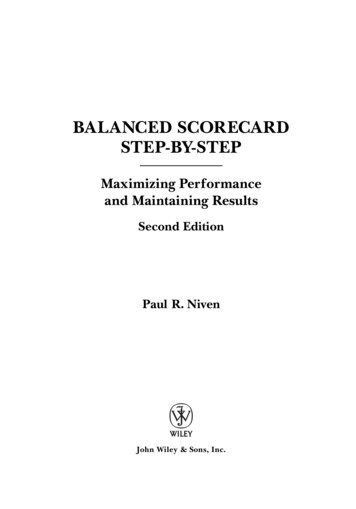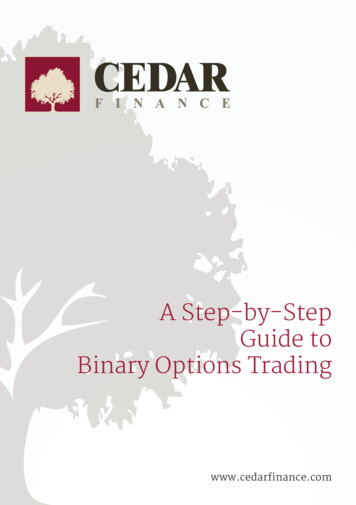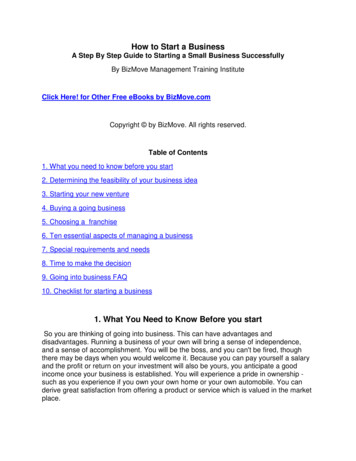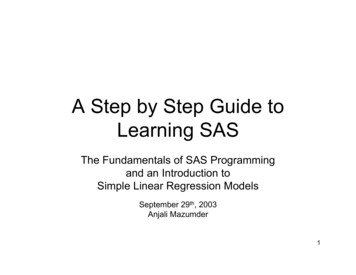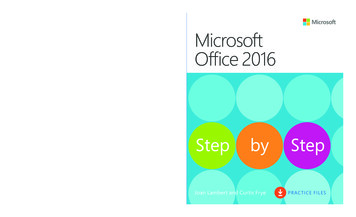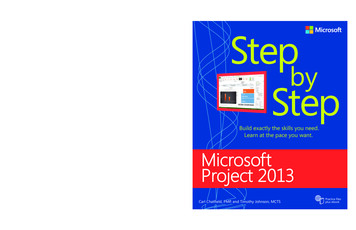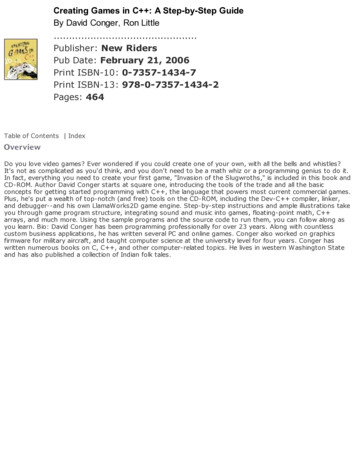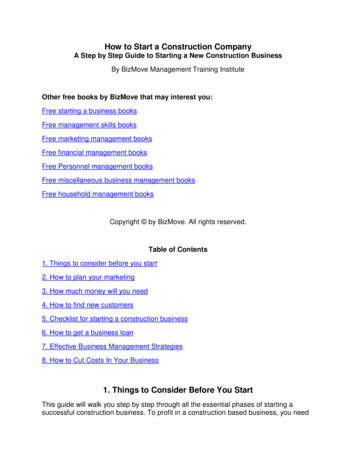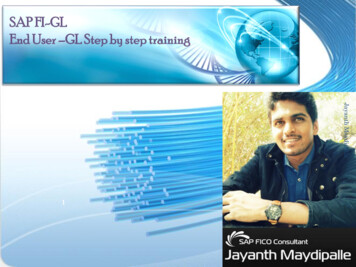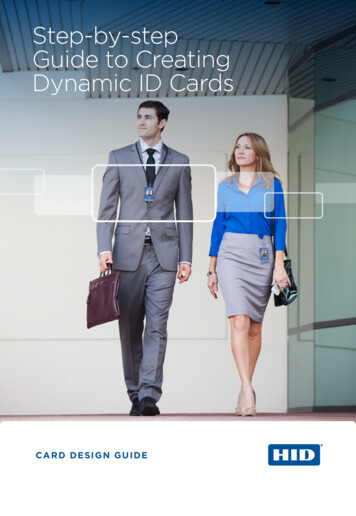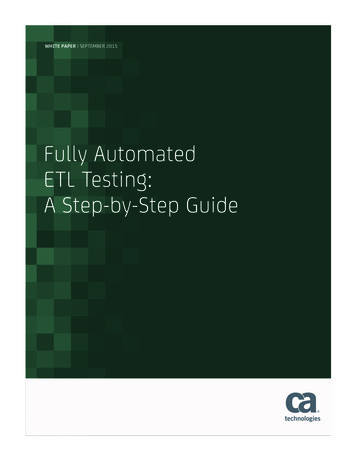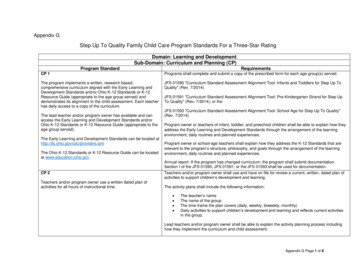
Transcription
Appendix GStep Up To Quality Family Child Care Program Standards For a Three-Star RatingDomain: Learning and DevelopmentSub-Domain: Curriculum and Planning (CP)Program StandardRequirementsCP 1Programs shall complete and submit a copy of the prescribed form for each age group(s) served.The program implements a written, research based,comprehensive curriculum aligned with the Early Learning andDevelopment Standards and/or Ohio K-12 Standards or K-12Resource Guide (appropriate to the age group served) anddemonstrates its alignment to the child assessment. Each teacherhas daily access to a copy of the curriculum.JFS 01590 "Curriculum Standard Assessment Alignment Tool: Infants and Toddlers for Step Up ToQuality" (Rev. 7/2014)The lead teacher and/or program owner has available and canaccess the Early Learning and Development Standards and/orOhio K-12 Standards or K-12 Resource Guide (appropriate to theage group served).The Early Learning and Development Standards can be located athttp://jfs.ohio.gov/cdc/providers.stmThe Ohio K-12 Standards or K-12 Resource Guide can be locatedat www.education.ohio.govJFS 01591 "Curriculum Standard Assessment Alignment Tool: Pre-Kindergarten Strand for Step UpTo Quality" (Rev. 7/2014), or theJFS 01593 "Curriculum Standard Assessment Alignment Tool: School Age for Step Up To Quality"(Rev. 7/2014)Program owner or teachers of infant, toddler, and preschool children shall be able to explain how theyaddress the Early Learning and Development Standards through the arrangement of the learningenvironment, daily routines and planned experiences.Program owner or school-age teachers shall explain how they address the K-12 Standards that arerelevant to the program’s structure, philosophy, and goals through the arrangement of the learningenvironment, daily routines and planned experiences.Annual report: If the program has changed curriculum, the program shall submit documentation.Section I of the JFS 01590, JFS 01591, or the JFS 01593 shall be used for documentation.CP 2Teachers and/or program owner use a written dated plan ofactivities for all hours of instructional time.Teachers and/or program owner shall use and have on file for review a current, written, dated plan ofactivities to support children’s development and learning.The activity plans shall include the following information: The teacher’s nameThe name of the groupThe time frame the plan covers (daily, weekly, biweekly, monthly)Daily activities to support children’s development and learning and reflects current activitiesin the group.Lead teachers and/or program owner shall be able to explain the activity planning process includinghow they implement the curriculum and child assessment.Appendix G Page 1 of 8
The plan shall be aligned to all developmental domains in Ohio’s Birth-Kindergarten Entry EarlyLearning and Development Standards or Common Core State Standards or both sets of standards;and to the relevant Ohio Academic Content Standards K-12.Sub-Domain: Child Screening and Assessment (CSA)Child Screening Program StandardCSA 1The program ensures that all children (except school-agechildren) receive a comprehensive developmental screening thatis valid and reliable within 60 days of entry into the program andannually thereafter. Necessary referrals are completed within 90days of identification of need, and the results are formallycommunicated with families.Staff is trained to administer, score and use the screening toolsappropriately.Child Screening RequirementsThe program shall record the name of the screening tool(s) obtained and document that thetool(s) is comprehensive and developmentally appropriate for the age groups served.The program shall maintain on file for review written documentation of the tool(s) staff membershave been trained to use that includes the staff members names.The tool(s) shall include the following domains: language, cognitive, motor, social and emotional andbehavioral.A program may identify more than one tool, depending on the age groups served and thedomains each tool addresses. If a program identifies more than one tool, it shall providedocumentation for each tool.The program shall keep on file for review screening tools that are completed for each child within 60days of enrollment and annually thereafter, results shall be communicated with the families.The documentation shall include the child’s name, date of enrollment, and date tool was administered,and date of referrals (if necessary).The program shall submit written documentation which outlines the program’s referral process and theidentified formal communication methods to share screening results with families.The program maintains written documentation of referrals made.CSA 2The program administers the state required assessment for allenrolled preschool aged children.CSA 3The program assesses all children enrolled (except school-agechildren) using formal and informal methods on an ongoing basisto inform instruction. Results are shared with families.Annual report: If the program is using new screening tools, the program shall submit an updated list ofthe screening tool(s) used as well as a list of staff who have been trained on the new tool(s).The program shall administer the Early Learning Assessment (ELA) following the schedule prescribedby the Ohio Departments of Education and Job and Family Services (ODE and ODJFS).The program shall submit a written description of the on-going child assessment process whichincludes: A description of the on-going process used for child assessment including that formalassessments are completed at least twice annually Identification of the standardized tool(s) used for formal assessments Methods by which child observations are conducted and recorded Identification of supporting evidence and the methods used to collect supporting evidence.Appendix G Page 2 of 8
Programs serving school-age children and stand-alone schoolage programs are only required to complete informalassessments with school-age children.The program shall keep on file for review examples of completed tools and supporting evidence of ongoing child assessment; as well as samples of information provided to families to share results.The program shall be able to explain the assessment process, methods, and how results are sharedwith families.CSA 4The program and parents work collaboratively to create twowritten developmental and educational goals within sixty days ofenrollment for children, and updated annually.Annual report: If the program has changed the assessment process, the program shall submit anupdate to the requirements listed above.The written goals shall include the name of the child, developmental and/or educational goals, theparent/guardian signature and date of completion. The written documentation shall clearly identify thefamily’s opportunity to develop the goals. The goals shall be updated annually.Sub-Domain: Interaction and Environment (IE)Program StandardIE 1The program completes an annual self-assessment using FamilyChild Care Environment Rating Scale, Revised Edition (FCCERSR) or other tool to measure the learning environment. The toolshall include staff/child interactions and be developmentallyappropriate to age groups served.IE 2The lead teacher and/or program owner in each group identifies atleast one area for improvement and creates an action plan whichincludes a goal and at least one action step based on the resultsof the annual self-assessment.IE 3The program supports each child’s development by providingwell-structured learning environments and positive interactionsamong staff and children.RequirementsThe program shall maintain written documentation of the completion of the self-assessment for eachgroup of children. The tool shall be developmentally appropriate to age groups served and shall becompleted annually.Note: The completion of the self-assessment tool shall not be used to meet the teacher observationprogram standard in the Administrative and Leadership Practices domain.Annual report: The program shall submit documentation of the completed self-assessment tool.The lead teacher and/or program owner in each group shall use the results of the self-assessment toidentify at least one area of improvement and develop an annual action plan. The written action planshall include: Teacher’s nameGroupDate completedName of tool usedGoalAction steps for achieving the goal Timeframe for completing the goalThe Ohio Classroom Observation Tool (OCOT) is conducted in randomly selected groups,representing the age groups the program serves which will be observed using a standardized toolembedded within the verification process. The tool will assess both the quality of the classroomenvironment and staff/child interactions. Programs will need to successfully meet the elements andindicators within the tool to demonstrate they meet this standard.Appendix G Page 3 of 8
Domain: Administrative and Leadership PracticesSub-Domain: Program Administration (PA)Program StandardRequirementsPA 1The program shall keep on file for review, the documentation of the completed, scored and dated selfassessment tool. The self-assessment shall be completed and/or updated annually and include thefollowing elements:The program completes an annual program self-assessmentusing a standardized tool that is used to assess a program’sadministrative policies, procedures and practices.ooooPA 2The program completes an annual continuous improvement planusing results from the current annual program self-assessment,which includes a minimum of two goals and at least two actionsteps towards completing the goals.Input from staff and families is also included in developing thecontinuous improvement plan.Human resource leadership and developmentFamily and community partnershipsProgram development and evaluationBusiness and operations managementAnnual report: The program shall submit documentation of the completed program self-assessmenttool.The program shall complete and submit the required sections of the JFS 01509 “ContinuousImprovement Plan For SUTQ” (Rev. 7/2014) for the three-star rating. The plan shall be updatedannually.The program shall be able to provide written examples of ways that staff and family input is gatheredand used to inform the continuous improvement plan.Annual report: The program shall submit the updated JFS 01509.Sub-Domain: Staff Management (SM)Program StandardSM 1The program owner completes the Ohio Administrator CoreKnowledge and Competencies Self-Assessment annually. All staff(other than program owner) have at least one formal observationannually.RequirementsThe program shall maintain an annual summary of the Ohio Administrator Core Knowledge andCompetencies Self-Assessment (Administrator CKC). The summary must include the date theAdministrator CKC was completed.The observation shall be updated and completed by the program owner within 30 days of hire andupdated at least annually. The program shall maintain a summary that shall include documentation ofthe formal observations for each staff member. The summary shall include the staff member’s nameand the date the observation was completed.Note: The completion of the classroom self-assessment tool or a self-evaluation by the staff does notmeet the requirement for formal observations.Annual report: The program shall submit documentation of all formal observations.Appendix G Page 4 of 8
SM 2A professional development plan is a written individualized plan used to document the on-goingtraining and professional development needs of staff, and shall be updated at least annually.The program owner and all staff have annual professionaldevelopment plans.For initial registrations: Professional development plans shall be created for any individual who hasbeen employed for more than 30 days.Once rated, the initial professional development plan shall be completed within 30 days of hire.Professional development plans shall be completed within 30 days of hire and updated at leastannually. It shall include the staff member’s name, date of hire, position, staff signature, date ofcompletion/update, and on-going training and professional development needs related to meeting theperformance goals indicated on the professional development plan.Annual report: The program shall submit documentation verifying that all of the professionaldevelopment plans have been updated annually.SM 3Results of the formal observations and the program owner’s selfassessment are used to inform individual professionaldevelopment plans.The program's professional development planning process shall include written documentation thatdemonstrates how the results of the formal observations were used to inform individuals' goals.Domain: Staff Qualifications and Professional DevelopmentSub-Domain: Staff Education (SE)Program StandardSE 1The program owner has an associate’s degree (AA) in anapproved related field or Career Pathways Level (CPL) 2 or anOhio's School-Age Administrator Professional Endorsement (ifserving only school-age children).One lead teacher (if not the program owner) has an AA in anapproved related field or a CPL 2 or an Ohio's Lead TeacherSchool-Age Professional Endorsement (if in school-age onlygroup).RequirementsThe program owner and all child care staff members shall create a profile in the Ohio ProfessionalRegistry (OPR) within 30 days of beginning employment. Individuals shall submit their education tothe OPR for verification, following the OPR’s established policies and procedures.https://www.occrra.org/oprDocumentation will not be considered complete until it has been verified by the OPR.Annual report: The program shall submit to the OPR documentation for verification of the educationqualifications.Approved related fields are defined in rule 5101:2-17-01 of theOhio Administrative Code.Appendix G Page 5 of 8
Sub-Domain: Professional Development (PD)Program StandardsRequirementsPD 1The program owner achieves and maintains the Step Up ToQuality Professional Development Certificate in the current orprevious biennium.All child care staff achieve and maintain the Step Up To QualityProfessional Development Certificate in the current or previousbiennium.Individuals who are currently enrolled in a degree-grantingprogram in early childhood or related field can use coursework tofulfill the biennial training requirement.PD 2The program owner and all child care staff shall complete therequired quality and child development courses.For initial ratings only: The program owner and all child care staff are not required to achieve theProfessional Development Certificate prior to registering for an initial rating. The program owner andall child care staff shall achieve the Professional Development Certificate prior to the end of thecurrent biennium. The required hours for the Professional Development Certificate shall be proratedbased on the rating effective date of the program’s initial rating.Once rated, the program owner and all child care staff achieve and maintain the Step Up To QualityProfessional Development Certificate in the current or previous biennium.If a child care staff member was hired after the program’s initial rating date, the required hours for theProfessional Development Certificate shall be prorated based on his or her hire date.The program owner and all newly hired child care staff are required to complete Ohio’s Approach toQuality and Ohio’s Overview of Child Development within 30 days of being hired unless they havedocumentation of the courses in the OPR or meets exemption requirements.The hours accumulated for these two courses will count as professional development hours.Any post-secondary child development course completed (with a grade of C or better or a passinggrade from a pass/fail course) within the previous six years from an accredited institution of highereducation shall count toward the Ohio’s Overview of Child Development regardless of degree.Documentation of the course shall be submitted to the OPR no later than sixty days prior to the end ofthe biennium.Domain: Family and Community PartnershipsSub-Domain: Transitions (T)Program StandardT1The program provides written information to families ontransitioning children into and out of the program.T2The program provides age-appropriate activities for children toprepare them for the transition to a new educational setting.T3The program transfers any child’s records to the new setting atthe family’s request and with the family’s written consent.RequirementsThe program shall submit copies of written information given to families on transitioning children intoand out of the program.The program shall submit and maintain documentation which describes age-appropriate activities forchildren to prepare them for the transition to a new educational setting. The documentation shallinclude the age group in which the activities were conducted and the purpose of the activity.The program shall submit and maintain a written policy explaining the procedure for obtaining familyconsent and for transferring records that the program and parents have determined to share duringthe transition.Appendix G Page 6 of 8
The program shall have available for review completed copies of the document used to obtain writtenfamily consent or a sample if no completed copies are available.The written consent shall include the child’s name, the name of the new setting that the records will bereleased to, a statement indicating the family would like the records released, the parent/guardiansignature, and the date of signature.The program shall have a plan that includes strategies to support the individualized needs of the childduring the transition process.T4The program meets with families to develop an individualizedtransition plan that supports a child’s transition to anothereducational setting.The plan shall include the name of the staff member completing the plan, the child’s name, theparent/guardian signature and date of development, and opportunities for family input.The program shall submit a document describing the process they follow for transition meetings.Sub-Domain: Communication and Engagement (CE)Program StandardCE 1The program obtains information about the family structure androutines that is important to the child’s development.CE 2The program provides information regarding a minimum of at leasttwo resources and community services to families.CE 3The program communicates with families using at least twodifferent modes of communication; and at least one modepromotes two-way communication.CE 4The program provides families with combined or separateinformation on at least one health topic and one childdevelopment topic annually that are appropriate to all age groupsserved at the program.CE 5The program offers at least one opportunity for all families toengage in activities annually.RequirementsThe program shall maintain the form used to collect family information with the child’s name andinformation about family structure and routines. This information shall be on file for all childrenenrolled at the program.The program shall submit documentation of at least two resources and community services providedto families to support the family and the development of their children.The program must show or be able to describe at least two modes of communication that the programuses to communicate with families.The program shall submit a combined or separate document(s) of dated information on one healthtopic and one child development topic provided to families.The program shall submit written documentation which describes the family engagement opportunitiesthat have been offered to families. The documentation shall include information describing the activityand to whom and when it was offered.Annual report: The program shall submit updated documentation of the family engagement activities.Appendix G Page 7 of 8
CE 6The program offers at least one educational tra
Feb 17, 2001 · enrollment for children, and updated annually. The written goals shall include the name of the child, developmental and/or educational goals, the parent/guardian signature and date of completion. The written documentation shall clearly identify the family’s opportunity t

